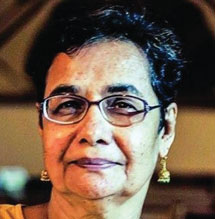Madhavi Desai
Tekton
Volume 5, Issue 2, September 2018
pp. 70 – 79
 Madhavi Desai is an architect, researcher, writer and a teacher. She is an adjunct faculty at CEPT University since 1986. She has had Research Fellowships from ICSSR, the Aga Khan Program for Islamic Architecture, Sarai and the Getty Foundation. She is one of the founder members of Women Architects Forum. She is the co-author of Architecture and Independence (1997) and The Bungalow in Twentieth Century India (2012). She was the editor of Gender and the Built Environment in India (2007) and the author of Traditional Architecture (2007).
Madhavi Desai is an architect, researcher, writer and a teacher. She is an adjunct faculty at CEPT University since 1986. She has had Research Fellowships from ICSSR, the Aga Khan Program for Islamic Architecture, Sarai and the Getty Foundation. She is one of the founder members of Women Architects Forum. She is the co-author of Architecture and Independence (1997) and The Bungalow in Twentieth Century India (2012). She was the editor of Gender and the Built Environment in India (2007) and the author of Traditional Architecture (2007).
Her most recent book, Women Architects and Modernism in India: Narratives and Contemporary Practices (Routledge, 2017) chronicles her research on participation of women in post-independence Indian architecture. She is at present working on an edited book, tentatively titled, Gender and the Indian City: Re-visioning Design and Planning. She is a member of the nominating committee of the Berkeley-Rupp Professorship and Prize at the University of California, Berkeley, USA since 2012.
In this Practice essay, Prof. Desai draws from her vast experience to dwell on the issue of research in India. She creates a comprehensive scenario as it exists of relationship of research with academia and practice, which is far from ideal. She comments on this while speculating on possible directions for research that can fill the gap in knowledge generation in the discipline.
Knowledge Generation in a Discipline
“The building industry, the architectural profession, the school of architecture – none is structured in a way that facilitates or promotes systematic inquiry for knowledge building.”
In any discipline, research is considered the core of knowledge production and theory generation. In architecture and design, in the perception of the society and within the profession, the practice and the practitioners have been at the forefront of the disciplines connected with the built environment. Despite of there being three wings of a discipline – practice, academics and research – the crucial component of research is relatively marginalized due to a lack of long standing and respected tradition in institutions of higher learning and in the architectural profession as well.
The development of scholarship in the field during the postcolonial times has been rather meagre, to say the least. Marginalization of knowledge creation deeply affects theory and application. As a result, there is a lacuna in well researched and documented publications or analytical studies on the Indian design sensibilities that are historical, regional or critical in nature. This limitation is acutely felt in teaching where a heavy reliance on western publications still exists, especially in courses on theory, history and technology. On the other hand, practitioners have traditionally relied largely on intuition, design principles and precedents in their design process. Most of them continue to do so because research and theory are not viewed as productive tools in actual practice. In addition, the architectural critic, who can play a role especially in improving the quality of public architecture and urban design is rather invisible in India. This essay attempts to take a broad look at the interconnectedness between research, practice and academics in India while stressing the urgency and importance of knowledge generation.
Practitioners have traditionally relied largely on intuition, design principles and precedents in their design process. Most of them continue to do so because research and theory are not viewed as productive tools in actual practice.
Background
The modern discipline of architecture is relatively young dating back to the colonial era. In the medieval period, edifices were constructed by craftspeople based on regional manuals that were derived from the principles of ancient building science treatises. Much change occurred when the profession of architecture got established and architects began designing from mid-nineteen century onwards. From British and other European architects who came from abroad, to European firms established in India who took on Indian architects as partners, to finally firms run by Indians, a great transformation occurred in the nature of the profession as well as the production of architecture.
(contd…)

